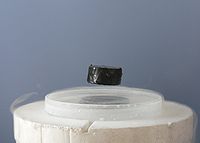
Photo from wikipedia
Holographic duality provides a description of strongly coupled quantum systems in terms of weakly coupled gravitational theories in a higher-dimensional space. It is a challenge, however, to quantitatively determine the… Click to show full abstract
Holographic duality provides a description of strongly coupled quantum systems in terms of weakly coupled gravitational theories in a higher-dimensional space. It is a challenge, however, to quantitatively determine the physical parameters of the quantum systems corresponding to generic holographic theories. Here, we address this problem for the two-dimensional holographic superfluid, known to exhibit strong dissipation. We numerically simulate the motion of a vortex dipole and perform a high-precision matching of the corresponding dynamics resulting from the dissipative Gross-Pitaevskii equation. Excellent agreement is found for the vortex core shape and the spatiotemporal trajectories. A further comparison to the Hall-Vinen-Iordanskii equations for point vortices interacting with the superfluid allows us to determine the friction parameters of the holographic superfluid. Our results suggest that holographic vortex dynamics can be applied to experimentally accessible superfluids like strongly coupled ultracold Bose gases or thin helium films with temperatures in the Kelvin range. This would make holographic far-from-equilibrium dynamics and turbulence amenable to experimental tests.
Journal Title: Physical review letters
Year Published: 2021
Link to full text (if available)
Share on Social Media: Sign Up to like & get
recommendations!